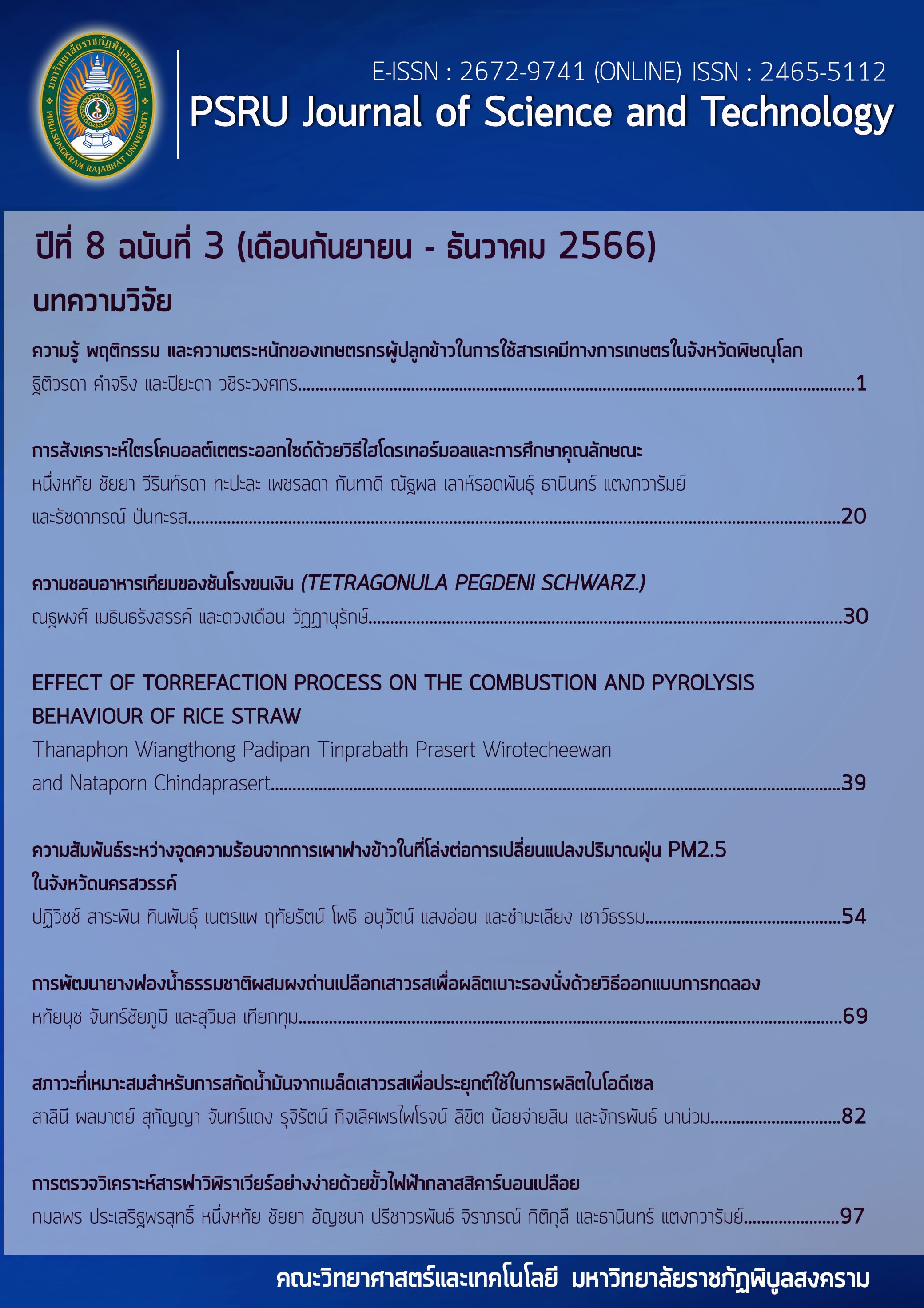HYDROTHERMAL SYNTHESIS OF TRICOBALT TETRAOXIDE AND CHARACTERIZATION
Keywords:
Cobalt oxide, Cobalt (II) nitrate, Hexahydrate, HydrothermalAbstract
Tricobalt tetraoxide (Co3O4) was prepared in this work by hydrothermal method using cobalt (II) nitrate hexahydrate as a starting material and sodium hydroxide as a reducing agent in an equimolar ratio. The reaction mixture was heated at 180°C for 1, 3, and 5 hours. Then calcination was heated at 500°C for 5 hours. The functional group of Co-O bond was studied by Fourier transform infrared spectroscopy (FTIR)and appeared at 570 and 665 cm1. The morphology of the Co3O4 was studied by Scanning electron microscopy (SEM) which revealed the aggregated shaped like a rice grain in shape with an average particle size of 0.5 micrometers. The crystalline structure was studied by X-ray diffraction (XRD) technique. The Co3O4 was a cubic structure with a lattice constant, a = 8.1100 angstrom. The crystallite average sizes were 16.83, 19.12 and 20.84 nanometers, respectively. In the future, tricobalt tetraoxide will be utilized as an active ingredient to inhibit bacteria and fungi in plant pathogens.
References
Abdallah, A.M., & Awad, R. (2020). Study of the Structural and Physical Properties of Co3O4 Nanoparticles Synthesized by Co-Precipitation Method. Journal of Superconductivity and Novel Magnetism, 33, 1395-1404.
Al-Tuwirqi, R., Al-Ghamdi, A.A., Aal, N.A., Umar, A., & Mahmoud, W.E. (2011). Facile synthesis and optical properties of Co3O4 nanostructures by the microwave route. Superlattices and Microstructures, 49(4), 416-421.
Bhargava, R., Khan, S., Ahmad, N., & Ansari, M.M.N. (2018). Investigation of structural, optical and electrical properties of Co3O4 nanoparticles. In 2nd International Conference on Condensed Matter and Applied Physics (ICC 2017). 030034. American Institute of Physics. https://doi.org/10.1063/1.5032369.
Das, D., & Saikia, B.J. (2023). Synthesis, characterization and biological applications of cobalt oxide (Co3O4) nanoparticles. Chemical Physics Impact, 6, 100137.
Dwivedi, A., Sharma, B.K., Rajagopalan, N., & Sinha, S. (2020). Hydrothermal Decomposition of Cobalt Hydroxide in Saturated Water Vapor. Industrial & Engineering Chemistry Research, 59(1), 491-496.
Fan, Z., Zhang, Z., Fang, W., Yao, X., Zou, G., & Shangguan, W. (2016). Low-temperature catalytic oxidation of formaldehyde over Co3O4 catalysts prepared using various precipitants. Chinese Journal of Catalysis, 37(6), 947-954.
Grybos, J., Hudy, C., Gryczynska, A., Piskorz, W., & Sojka, Z. (2020). Hydrothermal Synthesis of Euhedral Co3O4 Nanocrystals via Nutrient-Assisted Topotactic Transformation of the Layered Co(OH)2 Precursor under Anoxic Conditions: Insights into Intricate Routes Leading to Spinel Phase Development and Shape Perfection. Crystal Growth & Design, 20(12), 7771-7787.
Hou, Y., Kondoh, H., Shimojo, M., Kogure, T., & Ohta, T. (2005). High-Yield Preparation of Uniform Cobalt Hydroxide and Oxide Nanoplatelets and Their Characterization. The Journal of Physical Chemistry B, 109(41), 19094-19098.
Janjua, M.R.S.A. (2019). Synthesis of Co3O4 Nano Aggregates by Co-precipitation Method and its Catalytic and Fuel Additive Applications. Open Chemistry, 17(1), 865-873.
Lal, R., Bhatia, B.L., Tahira, A., Shaikh, S.F., Alsalme, A.M., Al-Othman, A.A., . . . , & Ibupoto, Z.H. (2021). Synthesis of composite material of cobalt oxide (Co3O4) with hydroxide functionalized multi-walled carbon nanotubes (MWCNTs) for electrochemical determination of uric acid. Journal of Materials Science: Materials in Electronics, 32(15), 20047-20057.
Lin, Y., Kan, K., Song, W., Zhang, G., Dang, L., Xie, Y., . . ., & Shi, K. (2015). Controllable synthesis of Co3O4/polyethyleneimine-carbon nanotubes nanocomposites for CO and NH3 gas sensing at room temperature. Journal of Alloys and Compounds, 639, 187-196.
Liu, B., Zhang, X., Shioyama, H., Mukai, T., Sakai, T., & Xu, Q. (2010). Converting cobalt oxide subunits in cobalt metal-organic framework into agglomerated Co3O4 nanoparticles as an electrode material for lithium ion battery. Journal of Power Sources, 195(3), 857-861.
Priyadharsini, C.I., Marimuthu, G., Pazhanivel, T., Anbarasan, P.M., Aroulmoji, V., Siva, V., & Mohana, L. (2020). Sol–Gel synthesis of Co3O4 nanoparticles as an electrode material for supercapacitor applications. Journal of Sol-Gel Science and Technology, 96(2), 416-422.
Shi, Y., Pan, X., Li, B., Zhao, M., & Pang, H. (2018). Co3O4 and its composites for high-performance Li-ion batteries. Chemical Engineering Journal, 343, 427-446.
Thota, S., Kumar, A., & Kumar, J. (2009). Optical, electrical and magnetic properties of Co3O4 nanocrystallites obtained by thermal decomposition of sol–gel derived oxalates. Materials Science and Engineering: B, 164(1), 30-37.
UmaSudharshini, A., Bououdina, M., Venkateshwarlu, M., Manoharan, C., & Dhamodharan, P. (2020). Low temperature solvothermal synthesis of pristine Co3O4 nanoparticles as potential supercapacitor. Surfaces and Interfaces, 19, 100535.
Xu, Y., Zhang, F., Sheng, T., Ye, T., Yi, D., Yang, Y., . . ., & Yao, J. (2019). Clarifying the controversial catalytic active sites of Co3O4 for the oxygen evolution reaction. Journal of Materials Chemistry A, 7(40), 23191-23198.
Downloads
Published
Versions
- 2024-05-29 (2)
- 2023-12-20 (1)
How to Cite
Issue
Section
License
Copyright (c) 2023 PSRU Journal of Science and Technology

This work is licensed under a Creative Commons Attribution-NonCommercial-NoDerivatives 4.0 International License.
กองบรรณาธิการขอสงวนสิทธิ์ในการปรับปรุงแก้ไขตัวอักษรและคำสะกดต่างๆ ที่ไม่ถูกต้อง และต้นฉบับที่ได้รับการตีพิมพ์ในวารสาร PSRU Journal of Science and Technology ถือเป็นกรรมสิทธิ์ของคณะวิทยาศาสตร์และเทคโนโลยี มหาวิทยาลัยราชภัฏพิบูลสงคราม และ
ผลการพิจารณาคัดเลือกบทความตีพิมพ์ในวารสารให้ถือมติของกองบรรณาธิการเป็นที่สิ้นสุด







